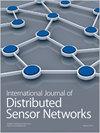一种改进的双宿架构,具有改进的媒体访问控制协议、能量感知和服务质量保证的无线体域网络路由算法
IF 2.5
4区 计算机科学
Q3 COMPUTER SCIENCE, INFORMATION SYSTEMS
International Journal of Distributed Sensor Networks
Pub Date : 2022-10-01
DOI:10.1177/15501329221102372
引用次数: 1
摘要
为了减少由于资源限制而导致的频繁传感器充电和更换,必须加强能源管理和网络服务质量。为此,本文提供了一种新的无线身体传感器网络架构,该架构具有两个汇聚节点和多种能量管理和服务质量算法。第一种算法是正常数据避免算法,其负责通过避免正常数据的传输来减少能量使用。重复数据避免算法避免传输重复数据,从而节省带宽和电池寿命。过去基于知识的加权路由算法监督信息传输的理想方向,从而提高服务质量。此外,还集成了睡眠调度,以进一步提高电池寿命。此外,在我们提出的模型中,基于数学模型的线性规划被用于对网络寿命最大化和连续数据传输最小化进行建模。通过在基于Castalia的OMNeT++中的仿真,表明我们提出的工作在网络寿命和延迟方面分别比支持的准睡眠抢占工作提高了50%和30%,并且在丢包和吞吐量方面分别提高了30%和75%。本文章由计算机程序翻译,如有差异,请以英文原文为准。
An improved dual-sink architecture with a modified media access control protocol, energy-aware, and quality-of-service guaranteed routing algorithms for wireless body area network
To reduce frequent sensor recharging and replacement due to resource constraint, it becomes imperative to increase the management of energy and network’s quality of service. To this end, this article provides a new wireless body sensor network architecture with two sink nodes and multiple energy management and quality-of-service algorithms. The first algorithm is the normal data avoidance algorithm that is responsible for decreasing the energy usage by avoiding the transmission of normal data. Duplicate data avoidance algorithm avoid transmitting duplicate data thus saving the bandwidth and battery life. Past knowledge-based weighted routing algorithm oversees taking the ideal direction to transmit information, hence improving quality of service. Furthermore, sleep scheduling is integrated to further improve the battery life. In addition, in our proposed model, linear programming which is based on mathematical models was used to model the network lifetime maximization and continuous data transmission minimization. Through simulation in Castalia-based OMNeT++ demonstrates that our proposed work outperforms the works of quasi-sleep-preempt-supported with regard to network lifetime and delay with 50% and 30% improvement, respectively, moreover, it improves the work of critical data with respect to packet drop and throughput with 30% and 75% improvement, respectively.
求助全文
通过发布文献求助,成功后即可免费获取论文全文。
去求助
来源期刊
CiteScore
6.50
自引率
4.30%
发文量
94
审稿时长
3.6 months
期刊介绍:
International Journal of Distributed Sensor Networks (IJDSN) is a JCR ranked, peer-reviewed, open access journal that focuses on applied research and applications of sensor networks. The goal of this journal is to provide a forum for the publication of important research contributions in developing high performance computing solutions to problems arising from the complexities of these sensor network systems. Articles highlight advances in uses of sensor network systems for solving computational tasks in manufacturing, engineering and environmental systems.

 求助内容:
求助内容: 应助结果提醒方式:
应助结果提醒方式:


